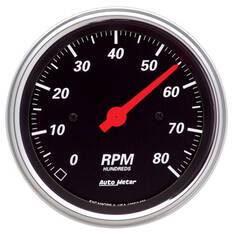The Importance of a Tachometer in Checking Engine Rate and Performance in Automotive Applications
In the world of automobile design, the tachometer stands as an essential instrument in the driver's collection, offering a direct window right into the internal functions of a car's engine. Beyond its function as a plain scale of revolutions per min (RPM), the tachometer works as a crucial tool for fanatics and professionals alike, supplying real-time understandings right into engine performance and wellness. Recognizing the significance of this tool exceeds surface-level monitorings, diving into the complex partnership between engine rate, power result, and total driving experience. As we check out the diverse function of the tachometer in vehicle applications, a much deeper appreciation for its influence on car characteristics and effectiveness starts to arise.
Value of Keeping An Eye On Engine RPM
Keeping track of engine RPM, or changes per min, is a critical facet of automobile maintenance and performance analysis. Engine RPM straight associates with the rate at which the engine's crankshaft rotates, suggesting how promptly the engine is running - tachometer. By keeping track of RPM, auto mechanics can evaluate the health and wellness of the engine, find possible concerns, and fine-tune performance. An abnormal RPM reading may indicate troubles such as engine misfires, defective spark plugs, or issues with the fuel shipment system. Consistently high RPM analyses could indicate hostile driving routines or the demand for a greater gear shift to improve fuel performance.
Moreover, keeping track of engine RPM is important for performance evaluation in racing and high-performance vehicles. In summary, keeping track of engine RPM is not only crucial for identifying concerns but likewise for enhancing engine efficiency in different auto applications.

Advantages of Real-Time Data
In vehicle applications, real-time data plays a crucial role in supplying immediate understandings into the performance and problem of the vehicle. By continually monitoring numerous specifications such as engine rate, temperature, fuel usage, and a lot more, real-time information uses numerous benefits that contribute to improved performance and safety when driving.
One substantial benefit of real-time data is its ability to alert motorists and specialists to any abnormalities or issues promptly. This proactive approach enables quick recognition of possible troubles, permitting timely treatments to protect against further damages or failures. In addition, real-time data assists in performance optimization by giving immediate responses on driving routines and engine efficiency. Drivers can readjust their actions in real-time based upon this info to accomplish far better gas economy and extend the lifespan of their vehicle.

In addition, real-time information plays an essential function in contemporary automotive diagnostics, enabling professionals to swiftly diagnose and deal with malfunctions. This causes lowered downtime, lower maintenance expenses, and ultimately, improved general automobile reliability and durability (tachometer). By taking advantage of the power of real-time information, vehicle stakeholders can make informed decisions that favorably impact both the performance and longevity of the car
Influence On Equipment Shifts
The tachometer plays a critical role in optimizing gear shifts by providing real-time engine rate data to the motorist. When approaching the redline on the tachometer, it indicates the chauffeur to upshift to prevent over-revving the engine and causing possible damage.
Additionally, the tachometer aids in attaining smoother equipment shifts, especially in manual transmissions. By keeping an eye on engine speed, chauffeurs can perform gear changes at the ideal RPM variety, reducing snagging movements and reducing wear on the transmission parts. This accuracy on duty modifications not only enhances driving convenience yet likewise adds to sustain performance.
Enhancing Fuel Efficiency
Offered the essential duty the tachometer plays in enhancing gear changes for performance and engine health, it straight adds to making best use of gas effectiveness in automobile applications. By offering real-time feedback on engine rate, the tachometer helps chauffeurs in maintaining one reference of the most reliable RPM variety for fuel economy. When vehicle drivers constantly monitor the tachometer and adjust their driving habits as necessary, they can prevent unnecessary fuel usage created by over-revving or carrying the engine.
In addition, the tachometer aids drivers determine the most fuel-efficient equipment to be in at any provided moment, stopping the engine from working tougher than essential. This is specifically critical throughout velocity and travelling, where remaining in the right gear can considerably influence gas efficiency. Additionally, the tachometer can alert drivers to potential mechanical issues that could be negatively affecting fuel economic situation, such as a sliding clutch or a stopped up air filter. To conclude, the tachometer works as an important tool in boosting gas effectiveness by advertising ideal driving practices and determining areas for improvement in the vehicle's performance.

Taking Full Advantage Of Engine Durability
The tachometer's duty in checking engine rate and efficiency is critical in making certain the longevity of automobile engines. By utilizing the tachometer efficiently, drivers can optimize engine long life with mindful RPM administration. Regularly revving an engine too high can lead to excessive damage on critical parts, such as the pistons, shutoffs, and bearings. With time, this can cause reduced engine performance and potential breakdowns. Checking the tachometer permits drivers to remain within the advised RPM variety for their car, preventing unneeded stress on the engine and prolonging its life expectancy.

Verdict
In final thought, the tachometer plays a vital role in monitoring engine speed and efficiency in automobile applications. By providing real-time data on RPM, it permits efficient gear shifts, boosted fuel performance, and made the most of engine long life. This tool is essential for preserving optimum engine performance and ensuring the general functionality of an automobile.